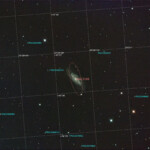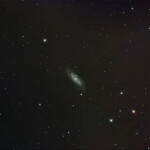NGC 3198, a is a barred spiral galaxy in the constellation Ursa Major. It was discovered by William Herschel on 15 January 1788. NGC 3198 is located in the Leo Spur, which is part of the Virgo Supercluster, and is approximately 47 million light-years away.
Observations made with the Westerbork Synthesis Radio Telescope detected the presence of extraplanar gas. Extraplanar gas is cold atomic hydrogen which has been discovered slowly rotating around some spiral galaxies and located well outside their thin disk regions. The extraplanar gas makes up approximately 15% of the total atomic hydrogen (HI) mass of the galaxy. Two supernovae have been observed in NGC 3198.

NGC 3198
Photographed with the RC8″ reflector telescope and the ASI 2600MC color CMOS camera in Stuvsta, April 12th, 2025. Exposure was 30*3 min with IDAS LPS D2 filter. Post-processing in Pixinsight. Full moon and no wind.
The Elliptical Galaxy PGC 2266491, to the left, is located at a distance of 2 500 million light-years from our solar system and is receding at about 16,2% of the speed of light.
